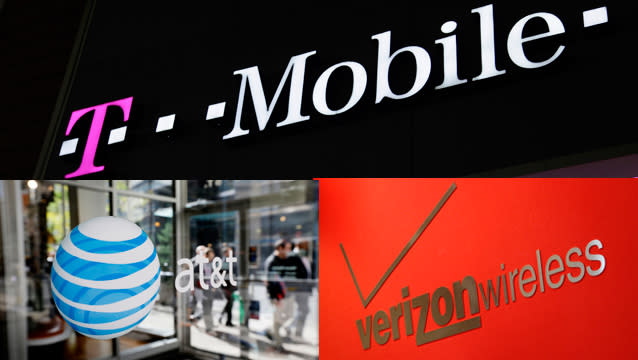Cellphone Upgrade Plan Winners: Customers or Carriers?

All of these early phone upgrade deals seem like an over-priced, confused mess. Spoiler alert: they are, for almost everyone.
That’s because customers have to sign up for higher payments at the start without knowing exactly when a new phone they want will be released. And they have to turn in their used phones to the carriers when they upgrade, forfeiting the resale value.
Fourth-place U.S. cellular carrier T-Mobile (TMUS), constantly trying to stir things up, was first with an early upgrade plan.
Previously, T-Mobile’s efforts to shake up the market included offering cheaper monthly plans with fees for service separated from payments meant to cover the cost of fancy smartphones. That was a breath of fresh air for the wireless market, not known for its transparency or pro-customer pricing. The bigger players largely ignored the move.
Related: Top 10 U.S. Cities Most at Risk for Smartphone Theft and Loss
But T-Mobile CEO John Legere’s latest wacky idea has ignited a firestorm of copying and controversy.
After Verizon (VZ) and AT&T (T) decided to make customers wait longer – up to two years – to qualify for getting a new phone at a low price, Legere decided to appeal to people who wanted more frequent upgrades.
Under T-Mobile’s new Jump plan, customers still benefit from T-Mobile’s pricing that separates monthly service from phone payments.
They can get a new phone with no up-front charge and pay off the value in installment payments over the next 24 months. An iPhone 5, for example, adds $27 a month.
In return for the ability to get a new phone as often as twice a year, customers also have to pay an extra fee of $10/month (though that also provides insurance coverage).
T-Mobile offers monthly service plans that cost less than the competition, even after including the separate installment payments for a phone, but the new fee complicates the analysis for anyone trying to compare deals.
To get a new phone, customers reset the clock on their two-year monthly installment plan and turn in their old phone -- in effect giving the residual value back to T-Mobile. That remaining value can be pretty hefty – a basic model iPhone 5 sells for over $400 on eBay. Gazelle.com will pay $300 outright for it.
Related: The Newest Risk for Apple Users & Shareholders
A typical Jump subscriber who starts with an iPhone and gets a new one after 12 months will have paid $2,328. They are also on the hook for another year of iPhone payments totaling $324. If they switch carriers or cancel the service, that remaining balance is due immediately.
But if they didn’t join Jump and just bought a new iPhone after 12 months for the full price $648, they will have paid $2,736. Plus they could sell the old iPhone and recoup much of the difference. And they are not on the hook for any more payments.
There are huge savings for those buying a new phone ever six months – more than $1,000 -- but the iPhone only comes out once a year. Including the residual value of the three phones turned in plus the continuing obligation to pay for the latest phone, even the earlier adopter might not be better off.
Related: Is Google Taking on the Telcos?
AT&T followed the Jump plan with its own Next plan. Under Next, customers get a phone with no up-front charge and then pay an extra fee per month depending on the value of the phone they choose. The extra fee – in addition to normal monthly service charges – is the phone full price split over 20 months. After 12 months, customers can turn in the phone for a new one, again with no up-front fee but with monthly fees for the phone extended for another 20 months.
The funny math in AT&T’s plan is that its regular monthly service charges are inflated to cover the cost of phone subsidies. But people signing up for Next and paying for their phone via extra monthly fees don’t get any discount on their service charge. On a basic iPhone 5, they don’t pay $200 upfront but they pay an extra $32.50 a month.
Verizon was last to bat. Its Edge plan, which starts at the end of August, may be even more complicated. There’s no up-front charge for a phone. Customers pay for the phone in 24 monthly installments. In as little as six months, customers can trade in the phone but they must have paid for at least 50% of its cost. Six divided by 24 is just one-quarter, so a typical Edge customer would have to pony up another one-quarter of the price to be eligible to trade up.
Waiting until month 12 or later obviously would not require additional payments. And as with the other plans, getting a new phone requires handing in the old phone and resetting the clock on the two-year installment plan.
Under the Edge plan, a typical iPhone customer upgrading after 12 months saves about $200 but loses the resale value of the first phone.
Under AT&T’s plan, an iPhone owner getting a new device after 12 months comes out less than $100 ahead of someone paying full price for the new phone and loses the resale value. But AT&T also offers a semi-discounted upgrade after 12 months to any customer – that erases the Next plan advantage completely.
Other than rabid new adopters, who are these plans good for? Not many. And for those willing to resell their old phone, even fewer.
Tell Us What You Think!
Send an email to: thedailyticker@yahoo.com.
You can also look us up on Twitter and Facebook.
More from The Daily Ticker:
American Dream Is Moving Out of the Suburbs and Could Leave Home Values Behind